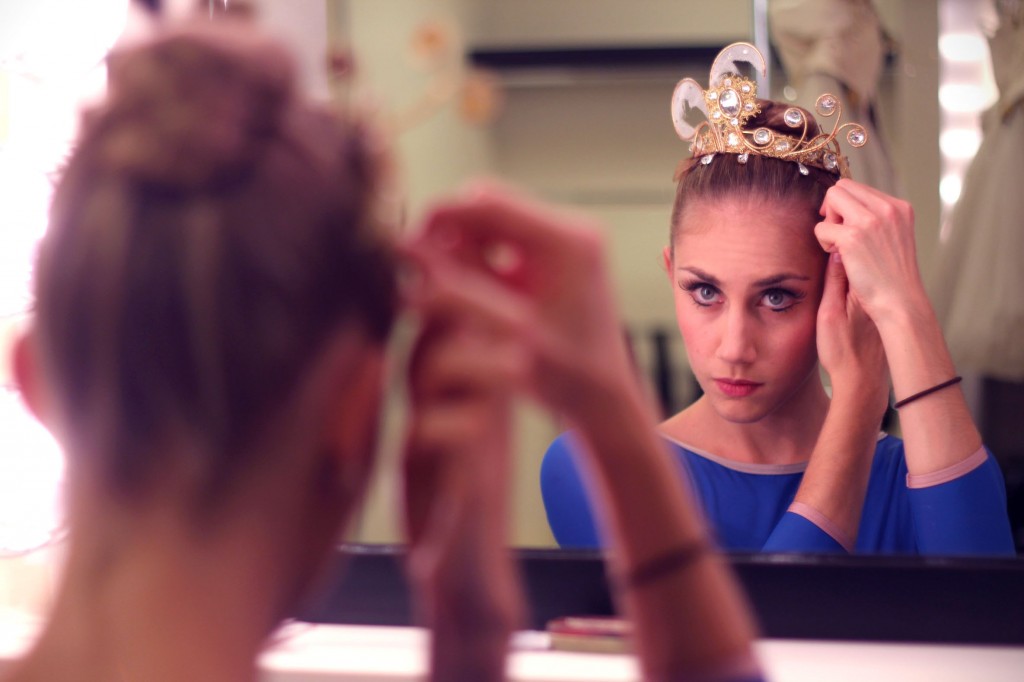
Today we are thrilled to welcome Pacific Northwest Ballet‘s Jessika Anspach McEliece to the site officially as a contributing writer. She’ll be writing about a variety of topics for us, starting with this post about George Balanchine’s “Jewels”, which the company will be performing, starting September 26th in Seattle.
by Jessika Anspach McEliece
It’s Tuesday but it feels like, um, I don’t know… not Tuesday. Coming back to work after a break always gives me that jet-lag feeling, no matter what time zone I’ve been in. PNB dancers are doing pirouettes across the grey marley floor of Studio C and between thinking about getting my foot immediately to passé and keeping my standing leg engaged, my rehearsal schedule for the day runs through the ticker tape of my brain. Confusion. Then holes. Then blanks.
I turn to the blonde girl with hyper-extension for days who’s patiently waiting her turn and ask, “Emma, do we have Rubies first or is it Emeralds?”
“I’m pretty sure we have Rubies 12-1 and Emeralds 1-2 but with the principal couple…” she replies. And yet I can tell that her ticker tape is following a similar pattern by her perplexed eyes.
“Oh yeah. That’s right… But I’m pretty sure Emeralds is only a half hour. I thought we had a break from 1:30 to 4, and finished with Diamonds. Is that just demi women or corps women too?” I reply.
“It’s demi and corps men and women. I think we’re piecing together the finale. Are you sure Emeralds is only a half hour?”
“Ha. I’m not sure of anything.”
Emeralds, Rubies and Diamonds – juggling these ballets can be a bit of a handful at first. Yes, Jewels is a full-length ballet. Yes, it has the same choreographer – the genius George Balanchine. All the costumes are designed by the same woman – the fabulous Karinska, and thankfully there’s not a single hair change during the performance… I think. But that’s about it when it comes to continuity.
No two stones are alike, and that is most definitely true of Jewels. Like any beautiful gem, we see the many facets of Mr. Balanchine’s choreographic prowess.
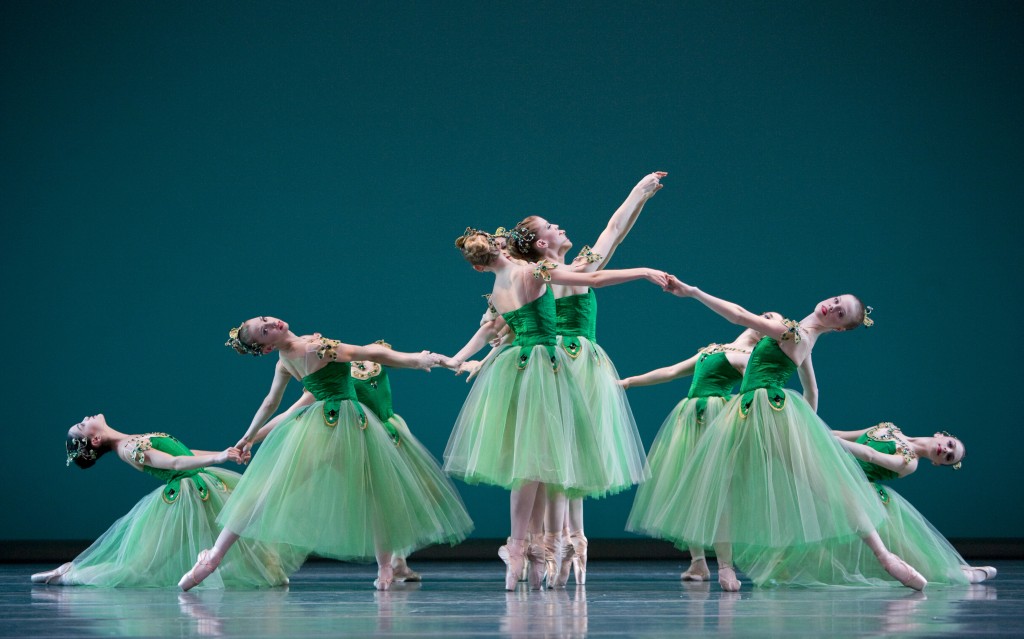
Emeralds
In Emeralds, set to the very French and very impressionistic music of Gabriel Faure, the movement is soft, yet sweeping. The curtain opens to a sea of emerald green: a principal couple dancing amid ten corps ladies who bourrée from one formation to the next, rarely coming off pointe. The effect: a floating, almost shimmering quality–like lily pads glistening on a glassy pond in one of Monet’s landscapes.
That is of course if it’s done right. Believe me it’s quite difficult to float and make your bourrées “shimmer” when you feel like your toes are about to fall off.
And in this ballet, a tremendous amount of emphasis is placed on port de bras and épaulement, as if the dancer’s own fingers, hands, shoulders and head were brushes painting a masterpiece onstage for the audience to see. In a sense this can feel incredibly liberating–to be completely submerged in fluid lyrical movement; to coquettishly play with the audience on stage; to feel the artist within emerge. And yet it can be a daunting task; to hold the audience’s attention not with 32 fouettés but with the turn of your head, the nape of your neck or the precision of your feet. In Emeralds it’s all about subtlety and nuance. Like I said, it’s very French.
Another challenging element of this ballet is not just mastering the quality of this ethereal piece, but, like a beautifully cut stone, maintaining the crispness of the formations and patterns Balanchine creates without becoming mechanical or rigid. It’s amazing how easily I drop one of those “balls,” if you know what I mean… One moment I’ll be intently focused on keeping my diagonal and the next I’ll catch a glimpse of myself in the mirror dancing like a robot. Yeah, not the look I’m going for. Especially in Emeralds.
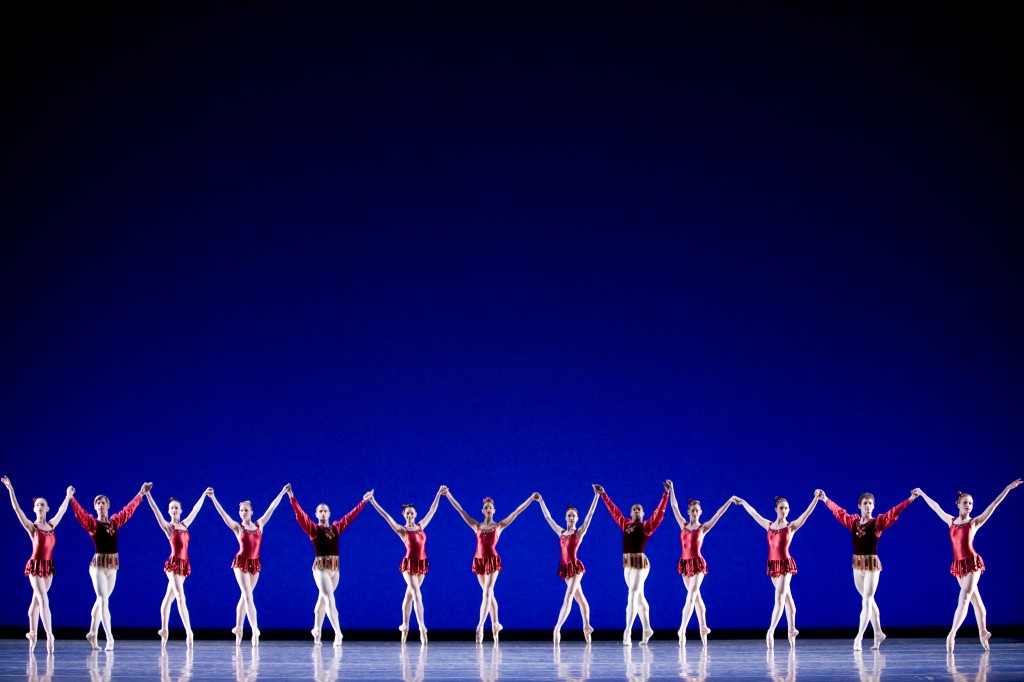
Rubies
Now Rubies on the other hand… As our lovely stager Elise Bourne puts it, “Rubies is the chutzpah of Jewels.” Forget soft and demure, Rubies is bold. It’s brazen. And it’s oh-so fun to dance. Gone are the images of Monet and Degas. With Rubies you get the feeling you’re dancing in some jazzy 1920’s nightclub. Flashy and sexy, sometimes even a bit shocking, the energy of this middle piece comes in stark contrast with its bookends. For me, making this transition seems a bit bi-polar at first but there’s nothing like an itty-bitty red costume and the eerily intense opening chords of Igor Stravinsky’s score to get me in the mood. In fact, the most challenging part of Rubies is the music.
Stravinksy, Stravinsky. Dancing to his music I find is either a love, or a hate relationship–there’s not a lot of middle ground. If you’re a mathematically-minded person and find yourself counting out every piece of music like me then you probably love it. But if you’re one of those dancers that just likes to “hear it,” good luck! With its uneven meter, crazy counterpoint and syncopated rhythms dancing Rubies is as much a mental workout as it is a physical one. A medium eight; a slow sing-songy eight; a fast nine and then a fast twelve–it’s enough to drive you mad. And heaven forbid you stop counting!
But it really is quite ingenious how Balanchine reveals the musical score to the audience through each dancer on stage, as if each of us represented an instrument in the pit or line of the score. There seems to be a balance between languid and staccato melodies in both music and movement–a conversational bantering back and forth on stage. In truth, Balanchine’s musicality in all of Jewels is quite masterful. But it’s up to me, up to all of us to convey that to the audience. If we aren’t precise it just looks like a mess of green, red or white on stage, depending on which piece we’re dancing. It’s a responsibility I take just as seriously as knowing the steps.
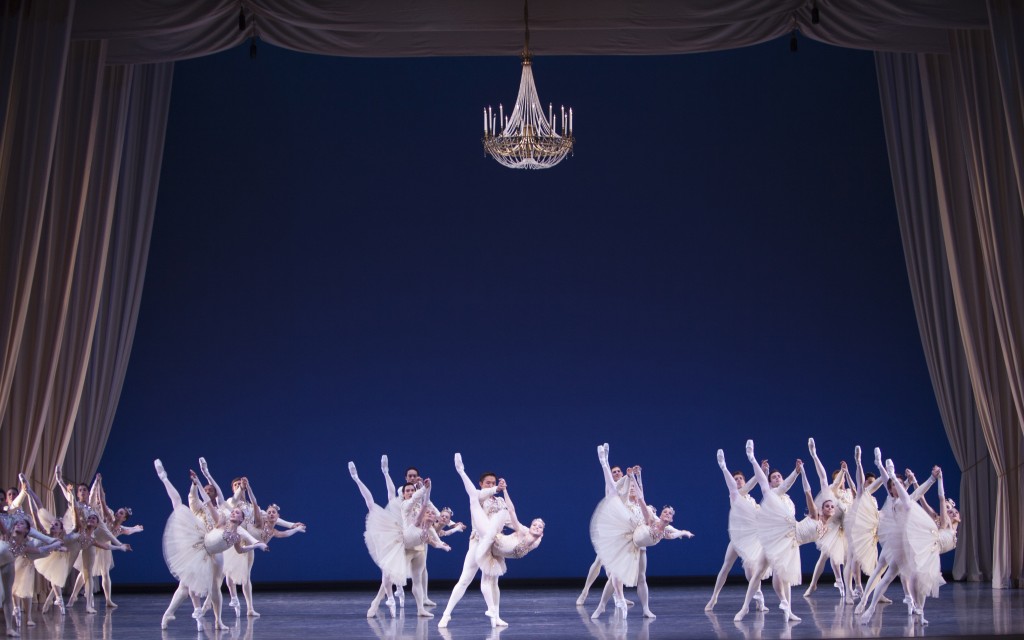
Diamonds
Diamonds is fortunately a little more straight-forward, musically speaking. But please don’t mistake “straight-forward” with “predictable” or “dull.” Diamonds is anything but dull. Set to the lush and opulent Symphony No. 3 in D major by Peter Ilyich Tchaikovsky the scene inspires audible “ooh’s” and “aah’s” from the audience as the curtain opens. Cream-colored curtains drape the once black wings, and a crystal chandelier hovers above the twelve corps ladies that are elegantly posed in, yes, a diamond formation. And it begins.
Maybe it’s the chandelier. Maybe it’s the tiaras, gloves and tutus. Or maybe it’s Tchaikovsky… But regardless of the origin, Diamonds just feels different. It’s more than glamorous… It’s regal. It’s royal. It’s Russian. Unlike Emeralds, there’s a weight to much of the piece–not heavy or clunky, but grounded. We don’t attempt to skim the surface of the stage but instead we use it, waltzing, jumping and turning with it firmly beneath our feet. And there’s certainly a hierarchical structure that you see more so in Diamonds than the previous two ballets. An old-world feel full of romance and formality–like a Tolstoy novel.
Diamonds, like Emeralds and Rubies, also relies heavily on formations and patterns–but there’s one considerable difference. Instead of say, 15 dancers on stage all executing the same step you have 38, making it exponentially more difficult to accomplish any sort of continuity or uniformity. We spend hours picking apart all the many details from settling together on the side to palms up or palms down, so that the end product is as clean and clear as, well, a diamond.
And I’m not sure if it’s just because we’ve performed two other pieces before getting to this “grand finale,” but it certainly feels like Diamonds demands an extra ounce of oomph. The choreography is deceptively athletic, making stamina (and Shot Blocks?) a must, especially if I plan on eating up the stage in the scherzo. Boy is that one ever puffy!
But in the end it’s all worth it. There’s something beautiful bordering on sacred when we all, the entire company, in unison develope our legs to that slow majestic music. It gives me chills every time. We stand together as 38–and yet we are one. There’s strength and there’s joy. And there’s a huge sense of accomplishment. Jewels is nearly over and I’ve survived!
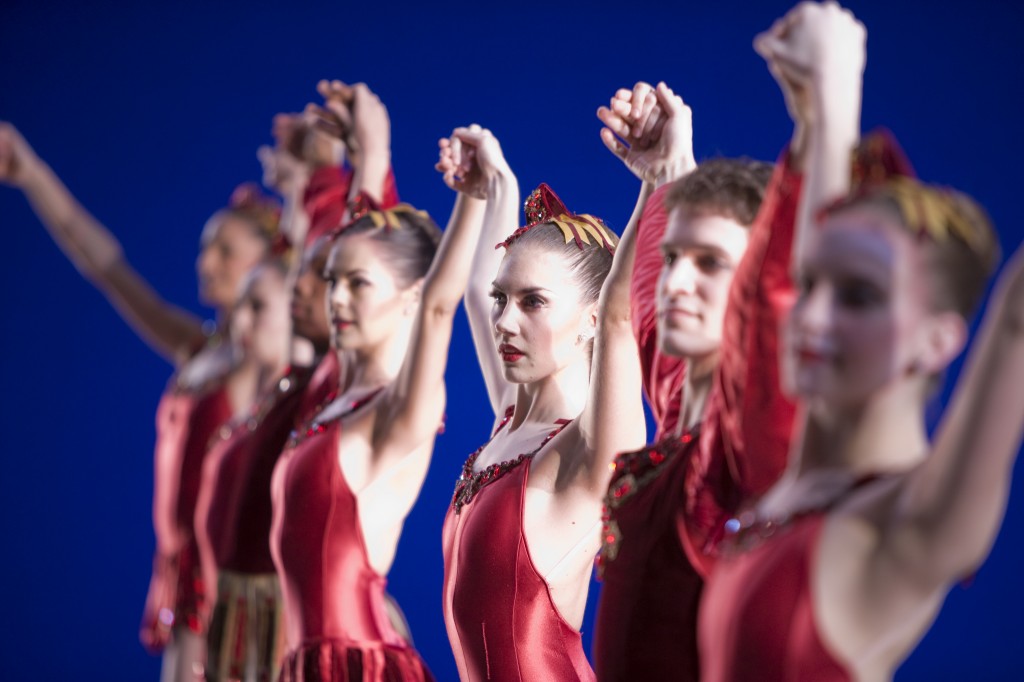
So how do I juggle these three very different pieces? It would be so easy to slip into complacency. No. I wouldn’t even call it complacency… that’s too lazy a word. To dance each one cleanly with glistening technique, but, well, to dance them all exactly the same. That’s what I’m getting at. It’s understandable, even acceptable I suppose. But I personally don’t think that’s doing Mr. Balanchine or any of those spectacular composers justice, nor is it benefiting the audience that has come to enjoy an exciting evening of ballet. Each piece is unique. Each piece has the bandwidth to grow me as an artist and performer. So that’s how I juggle them. I discover their difference and then I dance them. I embrace the many facets of Jewels.
The many facets of ballet.
Pacific Northwest Ballet performs “Jewels” September 26th and 27th and October 2nd, 3rd, 4th and 5th at McCaw Hall. Purchase tickets or learn more about their 2014-2015 season.

Contributor Jessika Anspach McEliece is from Bellevue, Washington. She received her training at Pacific Northwest Ballet School, beginning with Creative Movement classes and progressing through to the Professional Division.
In 2002, she joined the Suzanne Farrell Ballet as an apprentice. She joined Pacific Northwest Ballet as an apprentice in 2004 and was promoted to corps de ballet in 2005. Ms. Anspach’s writing on dance has been featured in Dance Magazine. She is also a frequent contributor to Pacific Northwest Ballet’s blog.





[…] made it this far and c) you’d like to read some more you can check it out by clicking here or the link below. I was asked by my editor, the lovely Catherine Tully, to write about our […]